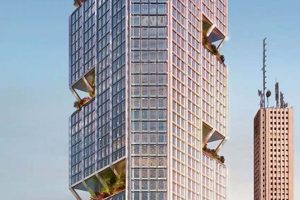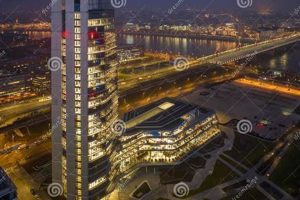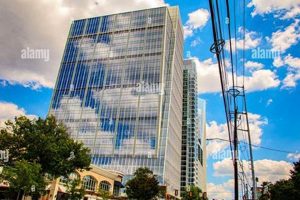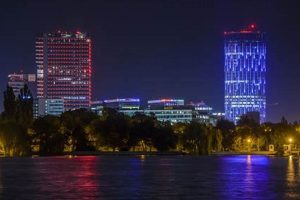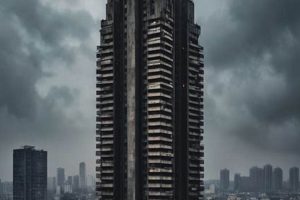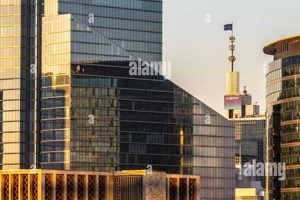Moscow skyscrapers are among the tallest buildings in the world, and they are a major part of the city’s skyline. The tallest skyscraper in Moscow is the Federation Tower, which is 374 meters tall. Other notable skyscrapers in Moscow include the Mercury City Tower, the OKO Tower, and the Eurasia Tower.
Moscow’s skyscrapers are a symbol of the city’s economic and political power. They are also a popular tourist destination, and they offer stunning views of the city. In addition, Moscow’s skyscrapers are home to a variety of businesses, including offices, apartments, and retail stores.
The history of Moscow’s skyscrapers dates back to the early 20th century. The first skyscraper in Moscow was the Moskva Hotel, which was built in 1935. In the 1950s and 1960s, a number of other skyscrapers were built in Moscow, including the Rossiya Hotel and the Ukraine Hotel. In the 21st century, there has been a boom in skyscraper construction in Moscow, and a number of new skyscrapers have been built, including the Federation Tower and the Mercury City Tower.
1. Height
The height of Moscow skyscrapers is a significant aspect of their architectural identity and contributes to their overall impact on the city’s skyline. The Federation Tower, the tallest building in Moscow, stands as a symbol of the city’s economic and technological prowess. Its impressive height allows for breathtaking panoramic views of the city, making it a popular destination for tourists and locals alike.
The height of Moscow skyscrapers also plays a practical role in the city’s infrastructure. Tall buildings can accommodate more occupants and businesses within a limited land area, helping to optimize space utilization in a densely populated urban environment. Additionally, skyscrapers can be designed to incorporate energy-efficient features and sustainable design principles, reducing their environmental impact.
Furthermore, the height of Moscow skyscrapers has a symbolic significance. They represent the city’s aspirations for modernity and progress. By constructing towering structures that reach towards the sky, Moscow asserts its status as a global metropolis and a major player in the international community.
In conclusion, the height of Moscow skyscrapers is not merely a physical attribute but also a reflection of the city’s architectural ambition, economic vitality, and global aspirations. These towering structures shape the city’s skyline, provide practical advantages, and serve as symbols of Moscow’s drive towards modernity and progress.
2. Architecture
The diverse architectural styles of Moscow skyscrapers reflect the city’s rich history and its aspirations for modernity. The neoclassical designs of buildings like the Ukraina Hotel recall the grandeur of the past, while the futuristic forms of skyscrapers like the Federation Tower symbolize the city’s embrace of innovation and progress.
The architectural diversity of Moscow skyscrapers is not merely aesthetic; it also serves practical purposes. The neoclassical buildings, with their thick walls and ornate facades, were designed to withstand the harsh Russian climate and provide comfortable living spaces. In contrast, the futuristic skyscrapers, with their sleek glass facades and aerodynamic shapes, are designed to be energy-efficient and environmentally friendly.
Understanding the connection between architecture and Moscow skyscrapers is important for appreciating the city’s unique character. The architectural styles of the skyscrapers reflect the city’s history, culture, and aspirations. They also provide insights into the practical challenges and opportunities that architects and engineers have faced in shaping Moscow’s skyline.
3. Engineering
The engineering of Moscow skyscrapers is a crucial aspect that ensures their stability and resilience in the face of challenging weather conditions. Advanced engineering techniques are employed to address the unique structural demands posed by these towering structures.
One key engineering consideration is the skyscraper’s ability to withstand strong winds. Moscow’s location exposes it to frequent high winds, and skyscrapers must be designed to minimize wind-induced vibrations and ensure structural integrity. Engineers employ advanced wind engineering techniques, such as wind tunnel testing and computational fluid dynamics simulations, to optimize the building’s shape and incorporate features that reduce wind resistance.
Another engineering challenge is ensuring the skyscraper’s stability against seismic forces. Moscow is located in a region with moderate seismic activity, and skyscrapers must be designed to withstand potential earthquakes. Engineers employ sophisticated seismic engineering techniques, such as base isolation systems and tuned mass dampers, to mitigate the effects of earthquakes and protect the building’s occupants.
Furthermore, Moscow’s harsh climate with extreme temperature variations poses challenges for skyscraper design. Engineers must consider the effects of thermal expansion and contraction on the building’s structure. They employ innovative materials and construction techniques to minimize thermal stresses and ensure the building’s integrity throughout the year.
Understanding the engineering behind Moscow skyscrapers is essential for appreciating their architectural achievements and resilience. The advanced engineering techniques employed in their construction allow these towering structures to withstand the challenges of harsh weather conditions and provide safe and habitable spaces for their occupants.
4. Symbolism
The symbolism of Moscow skyscrapers is deeply intertwined with the city’s identity and its aspirations. These towering structures represent the economic and political power of Moscow, showcasing its status as a major global metropolis. The grandeur and scale of skyscrapers convey a sense of strength, ambition, and progress, reflecting the city’s desire to be recognized as a prominent player on the world stage.
Moreover, Moscow skyscrapers symbolize the city’s aspirations for modernity and innovation. The sleek, contemporary designs of many skyscrapers embody the city’s embrace of new technologies and architectural trends. These buildings represent Moscow’s commitment to progress and its desire to be at the forefront of urban development.
Understanding the symbolism of Moscow skyscrapers provides valuable insights into the city’s self-perception and its ambitions for
the future. These structures are not merely architectural achievements but also powerful symbols of Moscow’s economic, political, and cultural aspirations.
5. Tourism
The connection between tourism and Moscow skyscrapers is significant, as these towering structures have become major tourist attractions in the city. Their unique vantage points offer breathtaking panoramic views of Moscow’s sprawling urban landscape, attracting visitors from around the world.
- Observation Decks: Many Moscow skyscrapers feature observation decks that provide visitors with unparalleled views of the city. These decks are often located at the highest points of the buildings, offering a bird’s-eye perspective of iconic landmarks, historical sites, and the cityscape stretching out in all directions.
For example, the observation deck of the Federation Tower, one of the tallest buildings in Europe, offers breathtaking views of the Moscow International Business Center, the Moskva River, and the Kremlin. Visitors can enjoy panoramic vistas that extend for miles, taking in the city’s architectural marvels and vibrant urban life.
- Restaurants: Some Moscow skyscrapers house restaurants and fine dining establishments on their upper floors, providing patrons with an unforgettable dining experience. These restaurants offer not only exquisite cuisine but also panoramic views of the city, creating a unique and memorable atmosphere.
For instance, the Sixty restaurant, located on the 62nd floor of the Federation Tower, offers a sophisticated dining experience with stunning views of Moscow’s skyline. Guests can indulge in contemporary Russian and international cuisine while enjoying the breathtaking panorama of the city.
- Tourism Industry: The presence of observation decks and restaurants in Moscow skyscrapers has had a positive impact on the city’s tourism industry. Tourists are drawn to these attractions, which offer a unique and memorable way to experience Moscow’s cityscape. Skyscrapers have become iconic landmarks, featured in travel guides and promotional materials, contributing to Moscow’s reputation as a vibrant and modern tourist destination.
The influx of tourists visiting Moscow’s skyscrapers generates revenue for the city and supports local businesses. It also contributes to the city’s cultural and social fabric, as visitors from diverse backgrounds come together to appreciate the architectural marvels and stunning views that Moscow has to offer.
In conclusion, the connection between tourism and Moscow skyscrapers is mutually beneficial. Skyscrapers offer tourists unparalleled views of the city, creating memorable experiences and contributing to Moscow’s appeal as a tourist destination. Conversely, tourism supports the city’s economy and enhances its cultural landscape, making Moscow skyscrapers not just architectural wonders but also valuable assets for the tourism industry.
6. Business
Moscow skyscrapers are not just architectural marvels but also hubs for business and commerce. They house a myriad of offices, apartments, and retail spaces, shaping the city’s commercial and residential landscape in significant ways.
- Office Spaces: Moscow skyscrapers provide vast office spaces for businesses of all sizes, from startups to multinational corporations. These high-rise offices offer modern amenities, state-of-the-art infrastructure, and prestigious addresses, catering to the needs of businesses seeking a competitive edge in the global marketplace.
For example, the Moscow International Business Center (MIBC) is a major business district that houses numerous skyscrapers, including the Federation Tower and the Mercury City Tower. These skyscrapers offer premium office spaces with panoramic city views, attracting leading companies from various industries.
- Residential Apartments: Moscow skyscrapers also offer luxurious residential apartments, providing upscale living experiences in the heart of the city. These apartments feature stunning views, spacious layouts, and exclusive amenities, catering to a discerning clientele.
For instance, the Neva Towers complex consists of three skyscrapers that house luxury apartments with floor-to-ceiling windows and private balconies overlooking the Moskva River. Residents enjoy access to a private park, a fitness center, and concierge services.
- Retail Spaces: The lower levels of Moscow skyscrapers often house retail spaces, offering a wide range of shopping options for residents, visitors, and employees working in the area. These retail spaces include luxury boutiques, international brands, and local businesses, creating a vibrant and diverse shopping experience.
For example, the podium of the OKO Tower features a shopping mall with over 100 stores, restaurants, and a cinema. It caters to the needs of the residents living in the towers and the surrounding neighborhood.
- Mixed-Use Development: Many Moscow skyscrapers are mixed-use developments that combine office, residential, and retail spaces within a single building. This concept promotes convenience and efficiency, allowing residents and employees to live, work, and shop in one location.
For instance, the Eurasia Tower is a mixed-use skyscraper that houses offices, apartments, a hotel, and a shopping mall. It offers a self-contained urban environment with easy access to various amenities.
In conclusion, the business aspect of Moscow skyscrapers contributes significantly to the city’s commercial and residential landscape. These skyscrapers provide modern office spaces for businesses, luxurious apartments for residents, convenient retail options, and mixed-use developments that promote efficiency and convenience. They are not just iconic landmarks but also vital components of Moscow’s thriving economy and vibrant urban fabric.
7. History
The connection between Moscow’s skyscrapers and their historical evolution is a fascinating aspect that showcases the city’s architectural journey. Moscow’s skyscrapers reflect the city’s architectural evolution, with older structures like the Moskva Hotel contrasting with newer constructions like the Mercury City Tower.
The Moskva Hotel, built in the 1930s, embodies the grandeur of the Stalinist architectural style with its ornate facade and imposing presence. In contrast, the Mercury City Tower, completed in 2013, exemplifies contemporary architectural trends with its sleek glass facade and dynamic form. These contrasting structures, standing side by side, narrate the story of Moscow’s architectural transformation over the decades.
Understanding the history of Moscow’s skyscrapers is essential for appreciating the city’s architectural diversity. It provides insights into the changing tastes, technologies, and influences that have shaped Moscow’s skyline. By studying the evolution of skyscrapers in Moscow, architects and urban planners can draw inspiration for future developments that balance historical preservation with modern innovation.
8. Innovation
The connection between innovation and Moscow skyscrapers is a testament to the city’s commitment to progress and sustainability. Moscow’s skyscrapers incorporate sustainable design features and advanced technologies, showcasing the city’s drive towards innovation in the construction and architectural sectors.
- Sustainable Design: Moscow’s skyscrapers are designed to minimize their environmental impact and promote sustainability. They employ energy-efficient lighting systems, water-saving fixtures, and green roofs that reduce heat absorption and improve air quality.
For example, the Evolution Tower is known for its innovative facade that incorporates solar panels to generate renewable energy. The tower’s design also optimizes natural light, reducing the need for artificial lighting and contributing to energy savings.
- Smart Building Technologies: Many Moscow skyscrapers are equipped with smart building technologies that enhance efficiency, comfort, and security. These systems include automated climate control, intelligent lighting, and advanced security features.
For instance, the Federation Tower utilizes a centralized building management system that monitors and controls various aspects of the building, including energy consumption, lighting, and HVAC systems. This automation optimizes the building’s performance and reduces operating costs.
- Vertical Greenery: Moscow’s skyscrapers often incorporate vertical greenery, such as living walls and rooftop gardens, to improve air quality, reduce the urban heat island effect, and enhance the aesthetic appeal of the buildings.
One notable example is the Neva Towers complex, which features lush vertical gardens on its facades. These gardens not only enhance the building’s appearance but also contribute to air purification and provide habitats for urban wildlife.
- Mixed-Use Developments: Many Moscow skyscrapers are mixed-use developments that combine residential, commercial, and retail spaces within a single building. This concept promotes sustainability by reducing the need for transportation and creating self-sufficient urban environments.
For example, the Eurasia Tower is a mixed-use skyscraper that houses offices, apartments, a hotel, and a shopping mall. This integrated design encourages residents and workers to live, work, and shop within the same building, reducing their carbon footprint and promoting a more sustainable lifestyle.
In conclusion, Moscow’s skyscrapers are not just architectural marvels but also showcases of innovation and sustainability. By incorporating sustainable design features, smart building technologies, vertical greenery, and mixed-use developments, Moscow’s skyscrapers contribute to the city’s environmental, economic, and social progress. These innovative skyscrapers represent Moscow’s commitment to building a sustainable and technologically advanced urban environment.
Moscow Skyscrapers
This section addresses common questions and misconceptions surrounding Moscow skyscrapers, providing informative answers to enhance understanding.
Question 1: What is the tallest skyscraper in Moscow?
Answer: The Federation Tower, standing at 374 meters tall, is the tallest skyscraper in Moscow.
Question 2: What architectural styles are showcased in Moscow’s skyscrapers?
Answer: Moscow’s skyscrapers exhibit a diverse range of architectural styles, from neoclassical designs to futuristic forms. Notable examples include the Ukraina Hotel’s neoclassical grandeur and the Federation Tower’s modern aesthetic.
Question 3: How do Moscow skyscrapers withstand the harsh Russian climate?
Answer: Moscow skyscrapers employ advanced engineering techniques to ensure stability and withstand harsh weather conditions. These techniques include wind engineering to minimize vibrations and seismic engineering to mitigate earthquake effects.
Question 4: What is the significance of Moscow’s skyscrapers?
Answer: Moscow skyscrapers symbolize the city’s economic and political power, as well as its aspirations for modernity. They represent architectural achievements and contribute to the city’s global recognition.
Question 5: How do Moscow skyscrapers contribute to the city’s economy and tourism?
Answer: Moscow skyscrapers house businesses, provide residential spaces, and offer tourist attractions such as observation decks and restaurants. They generate revenue, support local businesses, and enhance the city’s appeal as a tourist destination.
Question 6: What innovative features are incorporated into Moscow’s skyscrapers?
Answer: Moscow skyscrapers embrace innovation through sustainable design features, smart building technologies, vertical greenery, and mixed-use developments. These features promote energy efficiency, enhance comfort, improve air quality, and create self-sufficient urban environments.
These frequently asked questions provide a comprehensive overview of Moscow skyscrapers, addressing their architectural significance, engineering marvels, and contributions to the city’s economy and reputation.
Transition to the next article section: Moscow’s skyscrapers continue to shape the city’s skyline, serving as symbols of progress, innovation, and architectural prowess. Their diverse designs, advanced engineering, and sustainable features make them remarkable landmarks that contribute to Moscow’s identity as a global metropolis.
Tips for Understanding Moscow Skyscrapers
Grasping the significance and nuances of Moscow skyscrapers requires a multifaceted approach. Here are some essential tips to enhance your understanding:
Tip 1: Explore Architectural Diversity: Moscow’s skyscrapers showcase a wide range of architectural styles, from neoclassical to contemporary. Study the distinct characteristics of each style to appreciate the city’s architectural heritage and evolution.
Tip 2: Consider Engineering Marvels: These towering structures are feats of engineering. Learn about the advanced techniques employed to ensure stability and withstand Moscow’s harsh climate. Understanding the engineering challenges and solutions will deepen your appreciation for these architectural marvels.
Tip 3: Appreciate Symbolism and Significance: Moscow skyscrapers are more than just buildings; they symbolize the city’s economic and political power. Understand the historical context and cultural significance behind these structures to grasp their true meaning and impact.
Tip 4: Experience the Views: Many Moscow skyscrapers offer observation decks with breathtaking panoramic views of the city. Take advantage of these opportunities to witness the city’s vastness and architectural grandeur from a unique perspective.
Tip 5: Visit and Explore: Immerse yourself in the presence of Moscow’s skyscrapers by visiting them in person. Explore their surroundings, observe their architectural details, and appreciate their scale and impact on the cityscape.
These tips will enhance your understanding of Moscow’s skyscrapers, allowing you to fully appreciate their architectural, engineering, and symbolic significance.
In conclusion, Moscow’s skyscrapers are not just landmarks but also testaments to the city’s architectural prowess, economic vitality, and global aspirations. By embracing these tips, you can delve deeper into the world of Moscow skyscrapers and gain a richer appreciation for their m
ultifaceted nature.
Conclusion
Moscow’s skyscrapers are architectural marvels that have transformed the city’s skyline, symbolizing its economic and political power. Their diverse designs, advanced engineering, and innovative features showcase Moscow’s commitment to modernity and progress.
Understanding Moscow’s skyscrapers requires an appreciation of their historical context, architectural significance, and engineering prowess. These towering structures are not just landmarks; they are testaments to human ingenuity and ambition. As Moscow continues to grow and evolve, its skyscrapers will undoubtedly play a vital role in shaping the city’s future.


